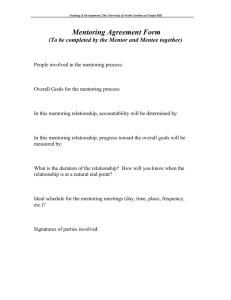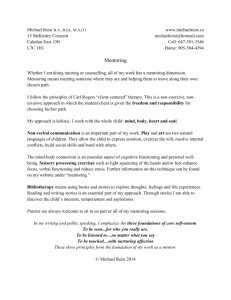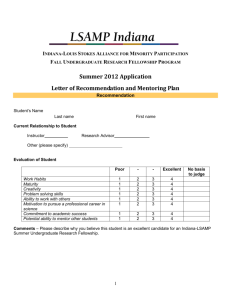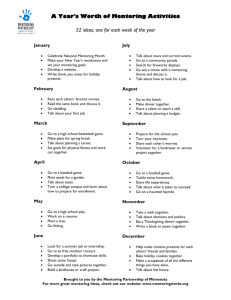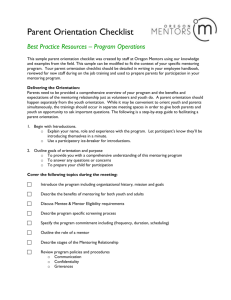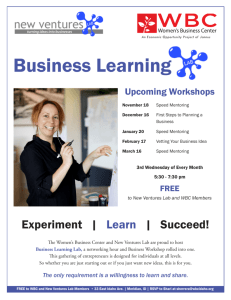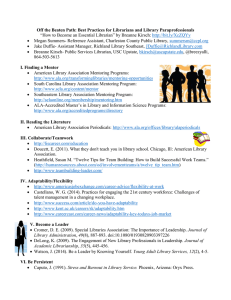Career Mentoring Equity and Diversity in the Sciences
advertisement
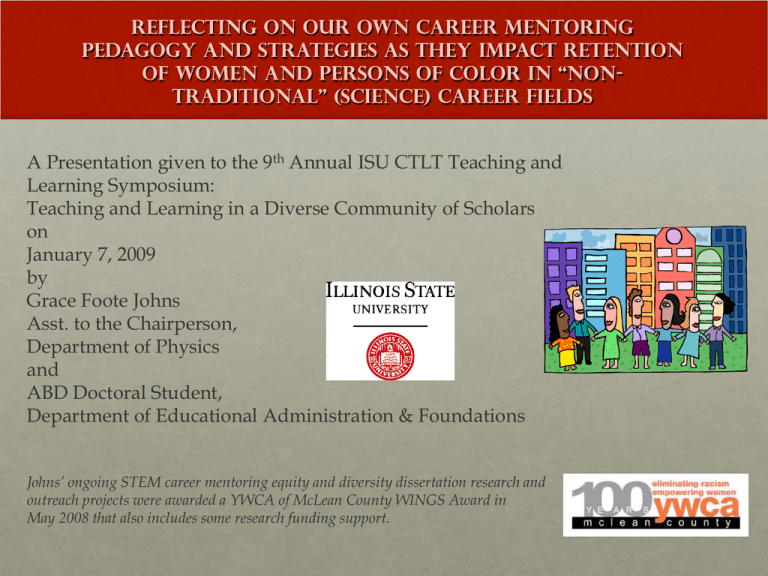
Reflecting on Our Own Career Mentoring
Pedagogy and Strategies as they Impact Retention
of Women and Persons of Color in “NonTraditional” (Science) Career Fields
A Presentation given to the 9th Annual ISU CTLT Teaching and
Learning Symposium:
Teaching and Learning in a Diverse Community of Scholars
on
January 7, 2009
by
Grace Foote Johns
Asst. to the Chairperson,
Department of Physics
and
ABD Doctoral Student,
Department of Educational Administration & Foundations
Johns’ ongoing STEM career mentoring equity and diversity dissertation research and
outreach projects were awarded a YWCA of McLean County WINGS Award in
May 2008 that also includes some research funding support.
Why Retention is important: The U.S. is in danger
of losing its technological competitive edge
Preston (2004) states that the “magnitude
of attrition from scientific jobs is
especially troubling at a time when, even
outside the scientific community, there is
a growing awareness that a productive
and well-trained scientific workforce is
essential to maintain a technologically
sophisticated, competitive, and growing
economy”.
Articles by other authors and national
organizations and agencies concur
(College Board, 2008; NSF, 2007).
One way to increase the talent pool is to
turn to historically underrepresented
groups in the sciences—women and
persons of color.(Czjuko et al, 2008;
Nicholson & Mulvey, 2008; American
Institute of Physics, 2007; NSF, 2007).
Undergraduate
Research:
Mentoring
the Next
Generation
of Scientists
A 2007 NSF study on the
population demographics
in the U.S. changing to
favor an increasing
population of non-white
racial and ethnic groups.
As educators, the changing
demographics of our
student populations
reveals our best source of
potential scientists to be
previous underrepresented
groups including women
and persons of color (see
chart at right).
Mentoring the next generation of
scientists:
Mentoring students in science and scientific research is a quest to instill in them the
skills necessary to become a scientific professional. Or, as one faculty member put it, in
my study of university science faculty mentors, to “grow” the next generation of
scientists (Johns, 2005). Therefore, faculty mentoring students is a professional
development activity they engage in to build the scientific workforce. Faculty in many
disciplines recognize the need for strong faculty and student mentoring relationships
(Fugate et al, 2001).
Often, the format of mentoring is relegated to successful one time programs, science
fairs, or summer camps—especially at the precollege level—rather than viewing it as an
ongoing relationship (Templin, 1999; Rodia, 2004; and National Academy of Science,
1997).
However, more research is being conducted about ongoing mentoring programs that
provide student assistance as well as role models (O’Neill, 1996; Johns 2004 and 2005).
The need for ongoing and more formalized mentoring programs is primarily recognized
when institutions focus on improving the representation and retention of
underrepresented groups (women and ethnic minorities) in the sciences (Preston, 2004;
Lundmark, 2004; Haynes, 2002; Thompson, 2002; Wood, 1999; and Rop, 1998).
As the number of scientists from underrepresented groups (especially women and
African-American undergraduates) grow, more attention, research, and assessment is
also paid to the importance of mentoring at the undergraduate level (Harding, 1993;
Fields, April 1998; Fields, October 1998; Fields, April 1998; Fields, October 1996; and
Fields, March 1998). However, the gender equity research is more developed and some
of its lessons can be applied to other underrepresented groups.
SOme Early Mentoring Tips
from the Trenches:
What follows are some Mentoring tips from other researchers that educators can use with
their students:
In Harding (1993), the chapter by Shirley Malcom on “Increasing the Participation of Black Women
in Science and Technology,” Professor Malcom speaks with a public policy voice as a member of
the national office of the American Association for the Advancement of Science. She summarized
some of the intervention strategies found in successful mentoring programs (p. 252-253):
starting early [in terms of exposure to science enrichment programs]
a continuing focus on rigorous preparation in science and especially mathematics through the
pipeline
promoting hands-on involvement through activities such as science fairs and projects
contact with role models who are minority women availability of appropriate career information
early exposure to research [in their chosen field]
directly addressing gender and race specific issues, such as combining marriage and family,
addressing clash of culture
an opportunity for early work experience in science-related employmen
In general, what works educationally for underrepresented groups (women and minorities), also
works for everyone else—we just need to remember to include women and minorities in these
enrichment activities.
Whether the under-representation of women in science career fields has to do with institutional
barriers or socialization and the need for better social networks, educators must understand the
complex systemic factors at work in the mentoring process through reflection and assessment. It
is the hope that initiating assessment projects such as this one will add to our knowledge about
what works and what does not work in recruiting and retaining undergraduate science majors—
especially individuals from under-represented populations such as women and persons of color.
Student Participation in Undergraduate
Research
In an early pilot study I conducted, I examined best practices in mentoring as a potential factor in
persistence in earning a B.S. degree in science. Science students interviewed at a large
Midwestern university all pointed to undergraduate research as being a key factor in their
development and retention (Johns, 2004).
“I would encourage people to do research. I think that is a very important thing to do.” Get involved in
a research project earlier.—Ann, Mary, Rachel
find a faculty mentor in your major early on—Katie
Males, also, identified that early opportunities to work on research helped them in their long range
career plans—including realizing that they did not want to do research.
•
“Alex” said “I’ve done things in the lab that will pertain directly to my future career…present[ing] at
research symposia;
•
“Sheila” said that her faculty mentor would offer her help and encourage her;
•
“Mary” said that “doing research with [name of her male professor]…is a very valuable experience.
•
In general, male student responses tended to be more positive on ratings and in their general
comments—one student said that his department “is like a family”.
•
“Katie” said that being one of only a handful of women in that field made them feel special , but that
there were challenges (“you have to hold yourself to a higher standard” [than males].
Results of IRB 2005-0111 Research Project
Follow-up studies of a diverse group of faculty science mentors and then their undergraduate research students of both genders at
this same large Midwestern university also revealed the importance of undergraduate research opportunities and career
mentoring to student retention (Johns, 2005a; Johns, 2005b).
What was revealed in extensive interviews of the seven science faculty undergraduate research mentors (one of whom was African
American and another was of Latino heritage) was an emerging theory of career mentoring pedagogies enacted by the faculty:
Table 1. Process Model of Best Practices in Mentoring
Best Practices in Faculty
Mentoring
Philosophies
Best Practices in Faculty Careering
Mentoring Strategies (involving
undergraduate research)
Women (and Men) Science
Undergraduate Learning
Outcomes
1.
1.
1.
2.
3.
Mentoring is an essential
part of what they do—
developing the next
generation of scientists.
Mentoring is focused on
student needs first and
their own research
agenda second.
Faculty recognize and
attend to differing
student needs (based on
career plans and
developmental stages).
2.
3.
Mentoring by faculty is an understood
requirement (an intrinsic reward)—they
also teach graduate students to be
mentors.
Faculty adapt research projects to fit
student needs and interests.
Faculty provide research experiences
that develop student skill sets—letting
students make some mistakes so they
realize that science is about regrouping
after dead ends, engaging them in
group discussions about their projects,
requiring them to write and present
their work
2.
3.
To develop broadly trained
scientists—who can work
independently and in a team-ready to meet the challenges of
graduate school or industry.
To nurture an enthusiasm for
science in students by
addressing their career interests.
To nurture students’ skills—lab,
problem solving skills,
presentation, writing, problem,
and self confidence.
Some Undergraduate Career Mentoring (CM)
trends that emerged were in three areas of:
(take 5 minutes to reflect and share on how you would respond to
each of these areas)
Purpose of CM
Strategies
faculty/staff used
in CM
CM Student
Learning Goals
More on losing our technological edge and Gender:
Women’s underrepresentation in physics creates a gender
imbalance
• Although increasing strides are being
made, after a high of 18% of Ph.D
graduates in Physics being women in
2002—since more foreign born
women added to that high--“the
representation of women among
physics PhD’s has dropped for the
second year in a row” in terms of
2005 graduation statistics (Mulvey
and Nicholson, 2007).
A report by the Special Conference of
the International Union of Pure and
Applied Physicists held in Paris,
France in 2000 focused on the U.S.
lagging behind other countries
(including Turkey) in educating
women in science and technology
(Urry, 2002).
More than half of the international
graduation rates of women in
physics exceed U.S. rates. The chart
at right lists graduation rates by
country from the International Study
of Women Physicists (Ivie and
Czujko, & Stowe, AIP, 2001).
More on losing our technological edge—
Gender imbalances
The American Institute of
Physics (Ivie & Ray, 2005)
reported on the incidence of
women completing bachelor’s
degrees by discipline (see right):
•Yet note that AIP (Ivie & Ray, 2005) also found that in 2001,
46% of the students taking HS physics were women (see left).
•So, why are less than half of those women obtaining
bachelor’s degrees in physics women?
why Women and Persons of Color are Underrepresented
in the Sciences: A Leaky Pipeline
Our Leaking Pipeline (Ivie and Ray, 2005; Ivie, Czujko, and Stowe, 2001) and negative climate
issues (Settles, 2007):
“Amid a few signs of recent progress towards more diversity in education and the workplace,
underrepresentation persists. For example, women and minorities continue to take fewer highlevel mathematics and science courses in high school; they still earn fewer bachelor's, master's
and doctoral degrees in science and engineering (S&E); and they remain less likely to be
employed in S&E jobs than are white males.” (NSF, 1996)
A study by Muller, Kinzie, and Stage (2001) using the NELS 88 data revealed that students who
were not “tracked” into college prep math and sciences—despite their abilities—usually were
from lower income groups whose parents were less able to afford outside of school enrichment
activities or amenities (home computers). Others concurred on the impact of family income
(Okpala, 2001; NSF, 1996; Hall, Davis, Bole, & Chia, 1999; Hortascu, 1995).
Parental educational attainment (Hall, Davis, Bolen, & Chia, 1999; Marjoribanks, 1996; NSF,
1996) and parental expectancy of their child’s profession (Preston, 2004; Kaplan, Xiaoru, and
Kaplan, 2001; Fan, 2001 ) were also found to be factors.
Students who would be first generation for attending college also have self-confidence issues:
Self-efficacy of their skills and abilities (Taylor, 2007; Pajares & Schunk, 2001). Expectancy
(Pintrich & Schunk, 1996) refers to students not wanting to try “a task whey they expect to fail”
and is also part of the self-efficacy issue. This fear of failure concept is found in all students, not
just women and minorities.
More losing our technological edge: The underpresentation
of Persons of Color in physics creates racial imbalances
The figure and description at right show current
bachelor’s degree production by race and
discipline (NSF, 2007).
An earlier NSF (1996) report Women,
Minorities, and Person with Disabilities in
Science and engineering reveals progress as
well as signs of persistent
underrepresentation by non-white racial
groups:
Blacks, Hispanics and American
Indians are taking more high school
science classes than in the past. The
percentage of blacks and Hispanics
taking chemistry and physics doubled
between 1982 and 1992.
Minorities (except Asians) remain a
small proportion of U.S. scientists and
engineers. Blacks, Hispanics and
American Indians as a group were 23
percent of the U.S. population, but 6
percent of the S&E labor force in
1993.”
However, Blacks are making significant
gains in their math and science NAEP
scores from age 9, age 13, and age 17
(see next slide):
MOre on losing our technological
edge—Racial imbalances
Though gaps still
persist, Black
students improved
their math
understanding-more so than their
science
understanding—as
assessed on the
NAEP tests (NSF,
1996).
These gains need to
be capitalized upon
in the sciences.
And, don’t forget, that we’re all working with a
different type of student—The Millennials:
•
Some insights about the Millennials:* according to Taylor (2007), many Millennials have a reduced
"self-efficacy" (the level of belief in their talents and skills); see also Albert Bandura, a leading
researcher in self-efficacy (www.des.emory.edu/mfp/self-efficacy.html)
•
Pintrich & Schunk (1996) studied the concept of "expectancy": which means that
"a task when they expect to fail."*
•
ISU's First Year Experience resource guide (2007) points out that Millennials have
experience being active agents in their own lives." (p. 12)*
•
ISU's First Year Experience resource guide (2007) has as a "Guiding Principle" that students "benefit
from being challenged and supported while making the
transition to college by academic
advisors…" (p. 3)
students won't try
"not much
What this means to us as educators working with Millennials in general:
•
* we need to recognize that a student's hesitancy or self doubt about their abilities might not be rooted
in fact
•
* we need to provide students with the data (math/science placement scores, HS Qtl, etc.) that tell us
that the student will succeed in the math or science placement
•
* we need to encourage students wanting “non-traditional” majors to follow their dream
What can we do as educators? We can make a
difference and why it is important:
Ma & Willms (1999) identified “critical junctures” where intervention is needed—8th and
11th grade. These are critical times when students are selecting high school courses to take as
well as final preparations for college such as achievement tests and taking the all important
4th year of math and science.
At no time previous has intervention been needed than with the millennial students. The
millennials (Chronicle of Higher Education, 2007) don’t have “much experience [in] being
active agents in their own lives” and they “benefit from being challenged and supported
while making the transition to college” (ISU’s First Year Experience Resource Guide
(2007).
Previously marginalized student groups need to make up for
lost time and do so with guidance and support networking from
their teachers and role models (Lee, 2002).
Who benefits? We all do by having developed more young minds
Who will contribute to society as their groundbreaking counterparts
have before them—Dr. Percy Julian and Dr. Jewel Plummer Cobb
(African American biologist and chemist, respectively); and
Dr. Rosalyn Franklin, Dr. Neil DeGrasse Tyson, and Dr. Shirley Jackson (Physicists), etc.
FINAL Thoughts on mentoring the next
generation of scientists:
In general, as educators:
We need to seek out high school students who are
behind in the number of math and science classes
they have taken and encourage them to pursue
more of those college prep type classes.
We need to recognize that a student’s hesitancy or
self doubt about taking math and science classes
might not be rooted in fact about their skills or
abilities.
We can provide role models for students who are
women and/or persons of color by seeking out
professionals who reflect those groups—as well as
being role models ourselves.
•In summary, mentoring is teaching
(Ramsden, 2003) by creating learning
environments where all students can grow
(Furman, 2003). By providing pathways for
change, mentors demonstrate moral leadership
and caring as they seek to create accessible,
safe, and nurturing learning environments for
all individuals (Furman, 2003; Fisher, 2001;
Noblit, 1993; Strathe, 2006; Heifetz, 1994).
Our “Traditional” picture of STEM scientists and inventors (right):
Our “New” pictures of today’s STEM scientists and inventors
sampled from ISU and AWIS-HOI websites (everything else):
SELEcted References
American Institute of Physics. (2007). Women in Selected Fiels: Bachelor’s degrees, 1966-2004.
(http://www.aip.org/statistics/trends/reports/spring07a.pdf downloaded 1/06/09).
Chronicle of Higher Education (2007). Meet the Millennials. From January 5, 2007 (section B, p. 10).
College Board. The. (2008). Coming to our senses: Education and the American future. A Report of the Commission on Access, Admissions
and Success in Higher Education. (www.collegeboard.com/comingtooursenses downloaded 1/06/09).
Czuko, R. Ivie, R., and Stith, J. H. (2008). Untapped talent: The African American presence in physics and the geosciences . American Institute
of Physics, Statistical Research Center (Pub. # R444), (www.aip.org/statistics/trends/reports/minority.pdf downloaded 1/06/09).
Fan, X. (2001). Parental involvement and students’ academic achievement: A growth modeling analysis. The Journal of Experimental Education,
70 (1), 27-61
Fields, C. D. (1998). Black geoscientists: Between a rock and a hard place. Black Issues in Higher Education, 15 (18), 16-17.
Fields, C. D. (1998). Black scientists: A history of exclusion. Black Issues in Higher Education, 15, (3), 12-16.
Fields, C. D. (1998). Highlights in U. S. science history. Black Issues in Higher Education, 15 (3), 17.
Fields, C. D. (1998). It’s not rocket science. Black Issues in Higher Education, 15 (3), 18-24.
Fields, C. D. (1998). Making mentorship count. Black Issues in Higher Education, 15 (3), 28-30.
Fields, C. D. (1998). A scant presence, Black and Latino faculty. Black Issues in Higher Education, 15 (March 5), 28 – 29.
Fields, C. D. (1998). Trouble along the science pipeline. Black Issues in Higher Education, 15 (2), 14-15.
Fields, C. D. (1998). Black scientists: Why are there still so few?. Black Issues in Higher Education, 15 (2), 13-14.
Fields, C. D. (1997). An equation for equity: Equity 2000 Program. Black Issues in Higher Education, 13 (February 20), 24-30.
Fields, C. D. (1996). Black peer mentors, cooperative advocacy beneficial to morale. Black Issues in Higher Education, 13 (October), 24-25.
Fisher, B. M. (2001). No Angel In the Classroom. Lanham, MD: Rowman & Littlefield Publishers.
Fugate, G. A., Jaramille, P. A., and Preuhs, R. R. (2001). Graduate students mentoring graduate students: A model for professional
development. PS Political Science and Politics, 34 (1), 132-133.
Fullan, M. G. (2001). Leading in a Culture of Change. San Francisco, CA: John Wiley & Sons.
Furman, G. (2003). The 2002 UCEA Presidential Address. UCEA Review, 65 (10), 1-6.
Hall, C. W., Davis, N. B., Bolen, L. M., and Chia, R. (1999). Gender and racial differences in mathematical performance. The Journal of Social
Psychology, 139 (6), 677-689.
Harding, S. (Ed.). (1993). The “Racial” Economy of Science: Toward a Democratic Future. Indianapolis: Indiana University Press .
Haynes, D. M. (2002). History: The missing link in making young scientists and scholars. Black Issues in Higher Education, 19 (21), 122.
Heifetz, R. A. (1994). Moblizing Adaptive Work. In Leadership Without Easy Answers. Cambridge, MA: Belknap Press of Harvard University
Press, 69-100
Hortacsu, H. (1995). Parents’ education levels, parents’ beliefs, and child outcomes. The Journal of Genetic Psychology, 156, 373-383
Illinois State University (2007). First Year Experience Guide. [Downloaded from www.ilstu.edu on 6/15/07.]
Ivie, R. Czujko, R., and Stowe, K. (2001). Women Physicists Speak: The 2001 International Study of Women in Physics. Ameri can Institute of
Physics: Statistical Research Center. [Downloaded from www.aip.org/statistics on 6/17/07.]
Ivie, R., and Ray, K. N. (2005). Women in Physics and Astronomy. American Institute of Physics: Statistical Research Center. [Downloaded
publication R-430.02 from www.aip.org/statistics on 6/17/07.]
Ivie, R. Czujko, R., and Stowe, K. (2001). Women Physicists Speak: The 2001 International Study of Women in Physics. Ameri can Institute of
Physics: Statistical Research Center. [Downloaded from www.aip.org/statistics on 6/17/07.]
Ivie, R., and Ray, K. N. (2005). Women in Physics and Astronomy. American Institute of Physics: Statistical Research Center. [Downloaded
publication R-430.02 from www.aip.org/statistics on 6/17/07.]
Johns, G. F. (2004). Enhancing the Academy: An Ethnographic Case Study of Women and Men Undergraduate Science Majors (IRB 2004-0188). For
completion of the Graduate Certificate in Womens’ Studies (and WS 400 Independent Study). (unpublished manuscript).
Johns, G. F. (2005a). An Ethnographic Case Study of Science Professors’ Career Mentoring Strategies for Undergraduate Women Science Majors
(IRB 2005-0111). For partial fulfillment of EAF 415 (Qualitative Research in Educational Settings). (unpublished manuscript).
Johns, G. F. (2005b). Formalizing Science Mentoring Assessment at Illinois State University: Enhancing Program Goals in Gender Equity and MultiCultural Diversity Career Mentoring. (IRB 2005-0111 expanded). For partical fulfillment of EAF 500 (Independent Research Study)
(unpublished manuscript).
Kaplan, D. S., Xiaoru, L., and Kaplan, H. (2001). Influence of parents’ self-feelings and expectations on children’s academic performance. The
Journal of Educational Research, 94 (6), 360-370.
Lee, J. D. (2002). More than ability: Gender and personal relationships influence science and technology involvement. Sociology of Education, 75 (
4): 349-373.National Science Foundation (1996). Women, minorities, and persons with disabilities in science and engineering: 19 96.
{Downloaded the report on 6/17/07 from www.nsf.gov/statistics/nsf96311/.]
Lundmark, C. (2004). Undergraduate mentoring program targets hard-to-find students. Bio-Science, 54 (1), 15.
Ma, X. and Willms, J. D. (1999) Dropping out of advanced mathematics: How much do students and schools contribute to the pr oblem? Educational
Evaluation and Policy Analysis, 21 ( 4): 365-383.
Marjoribanks, K. (1996). Ethnicity, family achievement syndrome, and adolescents’ aspirations: Rosen’s Framework revisited. The Journal of
Genetic Psychology, 157, 349-359.
Muller, P. A., Stage, F. K., and Kinzie, J. (2001). Science achievement growth trajectories: Understanding the factors rel ated to
gender and racial-ethnic differences in precollege science achievement. American Educational Research Journal, 38 (4), 981-1012.
Mulvey, P. J., and Nicholson, S. (2007). Enrollments and Degrees Report, 2005. American Institute of Physics: Statistical Research center
[Downloaded publication R-151.42 from www.aip.org/statistics on 9/17/07.]
National Academy of Sciences (1997). Advisor, Teacher, Role Model, Friend: On Being a Mentor to Students in Science and Engineering. National
Academy Press.
National Sciencte Foundation, Division of Science Resource Statistics. (1996). Women, minorities, and persons with disabili ties in science and
engineering, 1996, NSF 96-311 (Arlington, VA). (www.nsf.gov/statistics/nsf96311/ downloaded 1/06/09).
National Science Foundation, Division of Science Resources Statistics. (2007). Women, minorities, and persons with
disabilities in science and engineering: 2007, NSF 07-315 (Arlington, VA; February 2007). (www.nsf.gov/statistics/wmpd
downloaded 1/06/09).
Nicholson, S. and Mulvey, P. J. (2008). Roster of Physics Departments with enrollment and degree data, 2007. American Inst itute of Physics,
Statiscal Research Center (pub # R-394.14).
Noblit, G. W. (1993). Power and caring. American Educational Research Journal, (30), 23-38.
Okpala, C. O. (2001). Parental involvement, instructional expenditures, family socioeconomic attributes, and student achiev ement. The Journal of
Educational Research, 95 (2), 110-115
O’Neill, D. K. (1996). Online mentors: Experimenting in science class. Educational Leadership, 54, 39-42.
Pajares, F. and Schunk, D. H. (2001). Self-beliefs and school success: Self-efficacy, self-concept, and school achievement. In Riding, R. &
Rayner, S. (Eds.). (2001) Perception. London: Ablex Publishing, 239-266.
Palomba, C. A. and Banta, T. W. (1999). Assessment essentials: Planning, implementing, and improving assessment in higher education. San
Francisco, CA: Jossey-Bass.
Peter, K., L. Horn, and C. D. Carroll. (2005). Gender differences in participation and completion of undergraduate educatio n and how they have
changed over time (part of the Postsecondary Education Descriptive Analysis Reports series). National Center for Education S tatistics,
(NCES 2005-169).
Pintrich, P. and Schunk, D. H. (1996). Motivation in Educaiton: Theory, Research & Application, Chapter 3. Englewood Cliffs, NJ: Prentice-Hall.
Pomerantz, E. M., E. R. Altermatt, and J. L. Saxon. (2002) Making the Grade but Feeling Distressed: Gender Differences in Ac ademic
Performance and Internal Distress. Journal of Educational Psychology, 94 ( 2), 396-404.
Portes, P. R. (2000). Cognitive socialization across ethnocultural contexts: Literacy and cultural differences in intellec tual performance and
parent-child interaction. The Journal of Genetic Psychology, 161 (1), 79-98.
Preston, A. E. (2004). Plugging the leaks in the scientific workforce. Issues in Science and Technology, 20 (4), 69-74.
Rodia, B. (2004). The scientific mentor. Teaching PreK-8, 34 (5), 56-57.
Rop, C. H. (1998). Breaking the gender barrier in the physical sciences. Educational Leadership, 55, 58-60.
Rosser, S. V. (2002). A shift in focus from individual to institutional solutions to attract and retain women in science an d engineering. AWIS
Magazine, 31 (1), pp. 23 – 27.
Rosser, S. V. (1997). Re-Engineering Female Friendly Science. New York, NY: Teacher’s College Press).
Rosser, S. V., Editor. (1995). Teaching the Majority: Breaking the Gender Barrier in Science, Mathematics, and Engineering (Athene Series). (New
York, NY: Teachers College Press).
Rosser, S. V. (1990). Female-Friendly Science: Applying Women’s Studies Methods and Theories to Attract Students (Athene Series). New York NY:
Pergamon Press.
Settles, I.H., Cortina, L.M., Stewart, A. J., and Malley, J. (2007). Voice maters: Buffering the impact of a negative clim ate for women in science.
American Psychological Association, 35 (0361-6843/07), 270-281.
Strathe, M. I. (2006). Mentoring in the Changing academy: Attending to context. Women in the News: In their own words. [Retrieved (August
8, 2006) from the Women in Higher Education Website: http://www.wihe.com/$spindlb.query.showwhat2.wihe.58]
Taylor, M. (February 23, 2007). “Generation neXt comes to college.” Presented to Illinois State University. [Excerpted from Taylor, M. (2006). A
Collection of Papers on Self-Study and Institutional Improvement, 2004: 19–23.Chicago: The Higher Learning Commission.]
Templin, M. A., Engemann, J. F., and Doran, R. L. (1999). A locally based science mentorshp program for high achieving stud ents: Unearthing
issues that influence affective outcomes. School Science and Mathematics, 99 (4), 205.212.
Thompson, J. Engineering success for minority students. Techniques, 77 (1), 28-29
Urry, Meg. (Fall 2002). “IUPAP Conference Highlights: Adapted from the U.S Delegation IUPAP Conference Report.” In Radiations, The
Official Publication of Sigma Pi Sigm (a special issue on Measuring the Climate for Women in Physics), pp. 8-9.
Vetter, B. M. (1995). Status of Women in Science: Mentors Needed. A Hand Up: Women Mentoring Women in Science. Washington, D. C.:
Association for Women in Science, 267-270.
Wasonga, T., Christman, D. E., and Kilmer, L. (2003). Ethnicity, gender and age: Predicting resilience and academic achiev ement among urban
high school students. American Secondary Education, 32 (1), 62-74.
Whitten, Barbara L. (Fall 2000). Improving the climate for women in physics: Site visit program. CSWP Gazette, Committee on the Status of
Women in Physics of the American Physical Society, pp. 3 - 14..
Wood, J. M. (1999). The girls have it!. Instructor, 109 (6), 31-35.
